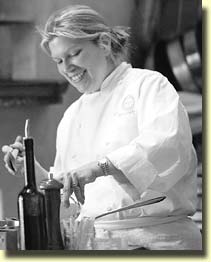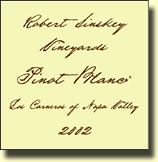
|
|||
|
|
|
||
|
The Concept | The Wines | Winemaker Interviews | Conclusions The Lunch
Pairing foods with wine takes understanding. Creating an all red wine menu requires talent. Crafting a luncheon menu for young Cabernet Sauvignon is
an enormous challenge demanding inspiration, brilliance and imagination. Maria Helm-Sinskey (right) possesses all of the
above. For those of you who follow the SF Bay Area dining
scene, Maria Helm might have fallen into the “what
ever happened to...” category. I assure you, only good things have happened to Maria
Helm. After achieving well-deserved notoriety and praise for
her work at PlumpJack Cafe, she appeared to have fallen off the radar.
It seems, however, that where she fell was in love. Maria is now married to Rob
Sinskey, “General Manager, Critical Palate and Daydream
Believer” of Robert Sinskey Vineyards. She is also the Culinary Director for RSV,
and fortunately for all of us, she has a cookbook that is about to be
published by HarperCollins. I’m on the mailing list for “Vineyard
Kitchen”, and if cookbooks reside on your shelves, I suggest you should
be, as well. The website
for the book will soon be online. Maria now works from an open kitchen adjacent to the
tasting bar at RSV, and it seems that there’s always something cooking. The
day of the event she was, of course, busy preparing six courses for a crowd.
But even on the day I went back to get some additional photos, there was a
tray of spiced almonds fresh out of the oven, and a colander full of gorgeous
spring onions waiting for the chef. This is obviously a ‘working’ kitchen. We moved from the cellar to the veranda, and started
with a taste of a limited production wine from Sinskey paired with absolutely
ethereal cheese puffs.
The wines served with lunch were poured at an
appropriate temperature, but were several degrees warmer than the samples we
tasted in the cellar. I was uniformly impressed with how much more expressive
and pleasurable the wines were when both warmer, and paired with food. It made
a tremendous difference. Wood Oven Roasted Porcini Tortelloni S Anderson Vineyard 2000 Cabernet
Sauvignon Most excellent! The tortolloni were perfectly al dente, and the dish carried the wines nicely. The Baldacci stood out in the flight: very impressive
– paired beautifully with the dish, which brought out the ripe and sweet
fruit flavors – far, far more impressive than when tasted at cooler cellar
temperature. Red Wine Braised Beef Shortribs with
Soft Polenta Clos du Val
2000 Cabernet Sauvignon The Braised Beef Shortribs brought back fond memories of
the short ribs and polenta we enjoyed at Tra Vigne back during the second
Bacchus tour, but this dish was lighter on its feet, and gentle on the palate,
despite being so rich and savory. Splendid. While tasting the flight of wine with this dish, I
confused the placement of the glasses, and was chagrined to find that it was
the Mondavi wine that I was enjoying so much. The herbal characteristics I
decried were nowhere to be seen, and the bright fruit and excellent balance
shone through. What a surprise! Herb Marinated Rack of Lamb with
Pan-fried Pine Ridge
Winery 2000 Cabernet Sauvignon The lamb was sublime, perfectly roasted, and the
decision to serve a natural jus was an excellent choice, and prevented the
dish from becoming ponderous. The Regusci Cabernet showed the brightest, sweetest
fruit and was my favorite with the dish, but the Pine Ridge and the Sinskey,
in their own ways, showed almost as admirably – both with slightly deeper
flavor profiles, but all of them were wines I would be happy to serve at my
dinner table. Selection of Local Artisan Cheeses Shafer
Vineyards 1999 Hillside Select Cabernet Sauvignon A lovely selection of cheeses was served
next, but I’m afraid that I was beyond notetaking by then. I do remember
nibbling on the cheeses with the last flight, but it was a rather
stylistically diverse group of wines, and I had difficulty evaluating them.
Certainly, the Shafer Hillside was in a group of it’s own – not
necessarily quality-wise, but style-wise. The Steltzner seemed to be in a more
ready-to-drink mode, the others were somewhere in between. However, by this
point, my critical palate was taking a nap. A light dessert course was offered – a soft cake with
a light creamy frosting and coffee for those who needed to return to work. I
declined, and engaged three of my dining companions in conversation. We
discussed the “sense of place” that makes Stags Leap special.
Stacy Clark, Winemaker, Pine Ridge Winery c – “Well, go ahead...tell me about Stags Leap, and how its terroir is expressed through your Cabernets.” SC – “Stags Leap District has a tannin
structure and a concentration that is different from most of the other areas
that we work with, and we have fruit from Howell Mountain, in the past we have
had Diamond Mountain, Rutherford, Oakville, etc. Stags Leap has a
concentration of black cherry, cassis, leaf type thing going on with a tannin
structure – that suppleness or that silkiness – that is in general, I
think, significant compared to the other ones. Warren Winiarski coined the phrase that’s very
convenient: “iron fist in a velvet glove.” It’s very true. I really feel
it’s very true. c – “When you talk about ‘leaf’ in the
flavors, are you describing an herbal character?” SC – “It’s not veggie, and it’s not
herbal – maybe it’s more a slight tobacco (?) as the wines age – when
the wines are young it’s as if things can be fruity, but there’s something
else there, too. It’s not particularly herbal, but it’s like a dry leaf,
or maybe a green leaf tobacco thing, but there is something in the fruit that
makes it more than the straight baked cherries or blueberries or whatever.
When you talk about fruit, when you look at wines, usually you see a fruit
quality, but there is something in there that is making it a little more
complex. I keep thinking of it as a ‘leaf’, and I think it may be a brown
leaf, as opposed to a green leaf. It’s not herbaceous, it’s not veggie,
but it’s a leaf." c – “Could you tell me just a little bit
about these tannins you mentioned, and where they come from?” SC – “You know, actually that’s kind of
interesting because I really, arguably, don’t know. The physiology of the
area is different than the rest of the Valley because of the Palisades and
because of the hills that wrap around (the District) – it creates a
Bernoulli Effect – there is a breeze that comes through there in the
afternoons, particularly during summer, that mellows things out. When you’re
driving down Silverado Trail in winter, or even in summer when you’re
hitting those fog patches – it will be clear upvalley, and you will hit fog
– you will almost always hit fog in Stags Leap. So, something is happening
here. Something is ‘trapped’ – there’s a difference in the air
movement, and consequently the temperatures. So, whether the ripening is more
gradual compared to some of the other (regions) – but there is a maturity in
the skins that is seemingly different, and there is a suppleness to the wines
that I can’t explain, but it seems to be going on there. And, that’s true of the Cabernets. We do a lot of
blending - we do a lot of Petit Verdot, Merlot, Malbec a little bit - with our
wines in general – they are Bordeaux blends – but there is still a
suppleness to that wine that shines. Even when you are looking at these other
wines, you see that suppleness to these wines. So...” c – “A certain indescribable something...”
(laughter) SC – “Yeah...” (more laughter) Tom Baldacci, Proprietor, Baldacci Family Vineyards c – “Tom, could you speak just a little bit
about what the Stags Leap District has to offer in Cabernet Sauvignon that is
unique to this appellation?” TB – “I think it has the most extraordinary
geology that is available in this valley. Within the context of the property
we have, there is a volcanic knoll that runs on the fringe and fans out to the
middle - from there you go on to some clay formations that are part of the
original Napa Valley River – so you have so many different formations, and
so many different varieties of climate that make a part of it – it is very
hard to categorize in one simple word or term or phrase. It really is a
collage of different formations that create that element.” c – “In your experience, what’s the common
thread that runs through Cabernet Sauvignon from this district?” TB – “Well, first off – (I don’t have)
great experience, so it’s more ‘opinion’. I think that the opinion within that context really does
tie the soft edge to the wines – the velvet context – a lot of reference
is made to the tannins that are part of it – whether it’s the volcanic
formations or the weather, it seems to predominate in all the wines that are
featured in this area. One of our assistants – Carol Garrett – has coined
the phrase “crushed velvet”, a velvet
type material that carries all these various Stags Leap wines.” c – “So, it’s a textural descriptor that
you’re referring to?” TB – “I think so. I think it is very
textural. Not only the taste, but the taste adds a number of different senses
that add to the experience. So, it’s not just the taste. It leads to a
feature which is not usually associated with wine tasting – the “feel”
– it really is a “feel” that you find yourself drawing upon as a part of
it. It’s amazing. (laughter) You’re smiling, but it
really is that kind of component. It’s hard to explain – I guess that’s
the mystery of it. There aren’t a lot of words that can characterize it.” Dick Steltzner, Owner, Steltzner Vineyards c – “Could we speak very briefly about what
it is that gives wines from the Stags Leap District their unique character?” DS – “Soil and climate. The vertical hills give us air movement, the air
movement gives us stress on the vine through transevaporation. That continual
and daily consideration makes a smaller leaf. A smaller leaf means that there
is less coverage of the grapes, so you have higher anthocyanin
(a phenolic compound) creation in the
skins – thicker skins – more concentration. Lighter soils drain well, early spring, longer
vegetative cycle means more hang time, which means you get more ripe
flavors.” c – “So it’s really a cascade of events.” DS – “All things are a cascade of events. "If you would take the air movement in Yountville vs. here, you will see we have 3 miles an hour more wind, hours sooner and later. And that means transevaporation increases, making the stomata close to lose less water. You don’t have high water (table) which stresses the vine. Stressing of the vine is just capability, and the leaf is going to close down – it’s going to grow slower because it isn’t going to have the amount of photoperiod, because it isn’t going to have the water to develop it, so we get a longer growing season. Those two weeks are very important. That’s the
difference between night and day.” c – “It’s the little things." DS – “A myriad of little things that add up
to intensity of flavor. And, then you have farming styles and winemaking
styles – but on a farming style, you can pull the trigger too soon, or can
you hang in there, stay there a little longer, let them ripen and not worry
about threatened rain – worry about the other side of it, because it’s
quality you’re after. If you don’t wait for quality, you won’t get it." c – “Is that as much of an issue for Valley floor growers as it is for folks up on the hills?” DS – “Yes, it is. Folks up on the hill have
less water holding capacity in their soils, and therefor are going to stress
their vines earlier due to lack of water. Now, if you have black hose hanging from vine to vine,
you are mitigating the difference because you can apply water. So, a mountain
vineyard is no different than a valley vineyard if you irrigate it. It’s
just how much you irrigate it. This whole water holding capacity and amount of water
available to the vine and the foliage and the grape, so “mountain grapes”
don’t mean anything if there’s black hose and there’s water behind it. I have a lot of black hose. I don’t have any water to
put in it. So – in essence, I’m dry farming. I can do it (irrigate) in the spring when we have a little water, but after May – June we don’t have any water, so black hose is just ornamental. I can’t apply water, but if you have water, you can apply it. So you can take very poor soils and make them as productive as Valley soils if you can continue to supply the water.” c – “Has the water table dropped
significantly on the Valley floor over the years?” DS – “It is in our area, in the Stags Leap
here, because we’re fracture rock – our replenishment is not as high as
you would have in alluvial deposits where it’s an annual renewal. In 1965,
the first well I drilled was 65 gallons a minute. That same well is 30 gallons
a minute now. So I would say there has been a depletion in thirty-five years.
There’s also another dozen wells.” c – “If you drilled deeper, could you get
more water at a better flow?” DS – “I’m only 600 feet. I don’t want to look from 600 to 1000 only for financial considerations. And no guarantees.”
© Allan Bree July 2003
|
|||



 Robert
Sinskey Vineyards 2002 Pinot Blanc Los Carneros – beautiful floral
aromatics – the wine sees no oak at all, and that accounts for its wonderful
fruit and beauty – it is delightfully fresh and lovely, and unique in a
world of Pinot Blanc that attempts to masquerade as Chardonnay. A perfect
choice to start.
Robert
Sinskey Vineyards 2002 Pinot Blanc Los Carneros – beautiful floral
aromatics – the wine sees no oak at all, and that accounts for its wonderful
fruit and beauty – it is delightfully fresh and lovely, and unique in a
world of Pinot Blanc that attempts to masquerade as Chardonnay. A perfect
choice to start.